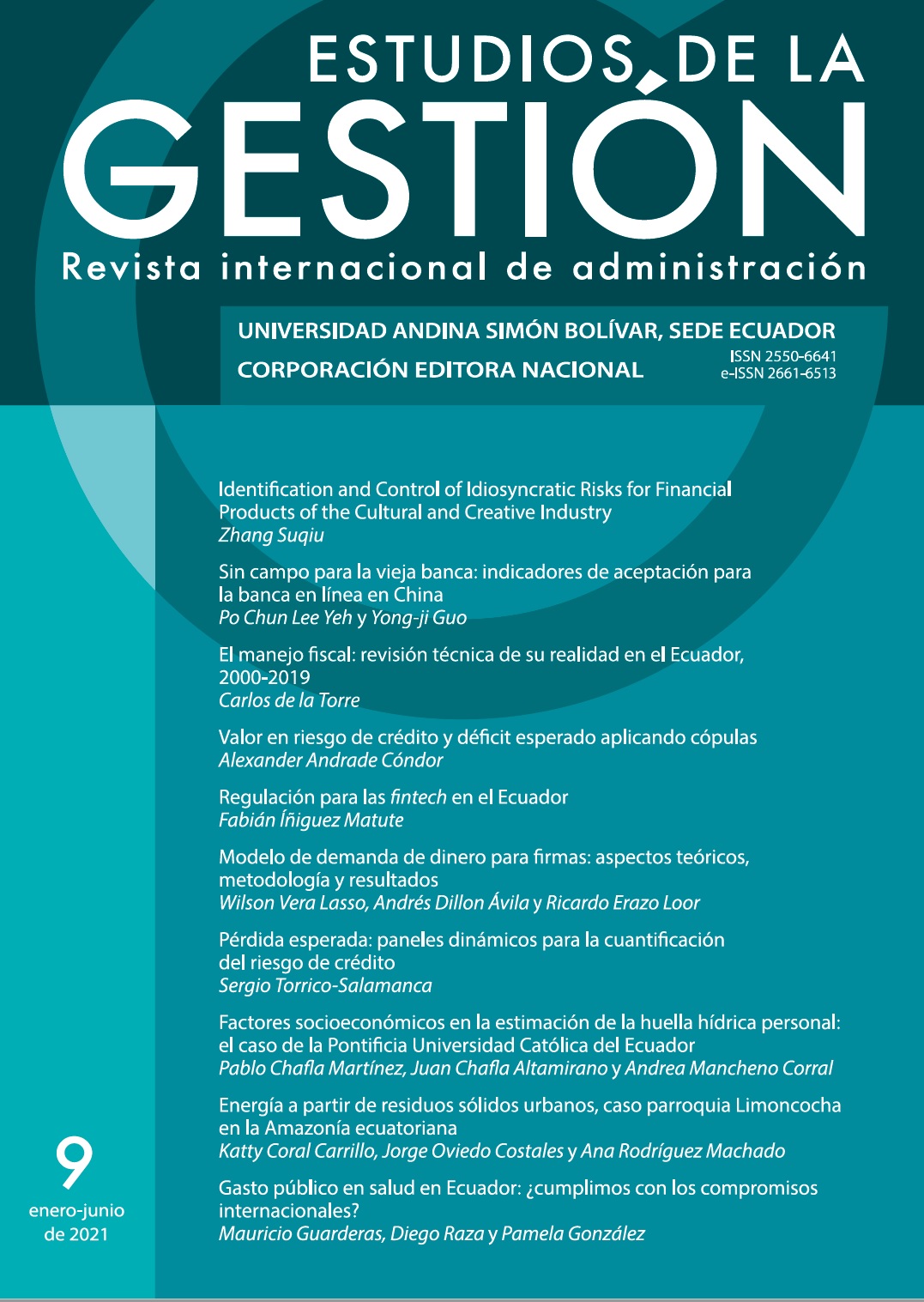Identification and Control of Idiosyncratic Risks for Financial Products of the Cultural and Creative Industry
DOI:
https://doi.org/10.32719/25506641.2021.9.1Keywords:
Financing cultural and creative industry, idiosyncratic risk, risk identification, multiple quality signalsAbstract
This research explores the discrete and diversified characteristics of the cultural and creative industry (CCI) to identify and control their idiosyncratic risk in the open financial market. This article selects a panel data of cultural and creative companies listed in the Tianjin Cultural Art Exchange Market for the 2011 to 2017 period, to identify the influencing factors of their idiosyncratic risks through a multiple quality signal model. The results show that liquidity, market risk, and the characteristics of the cultural and creative industry have a significant impact on its idiosyncratic risk. It is worth noting that the impact of market risk on the idiosyncratic risk of publicly traded cultural and creative companies is limited within the industry, while trading of the external financial system has no significant impact on the idiosyncratic risk of the cultural and creative industry, therefore incurring no investment substitution effect. This paper concludes that the idiosyncratic risk of the CCI can be identified and controlled based on the liquidity, market risk and trading patterns of the cultural and creative companies listed in an open financial market. This helps creative industry entrepreneurs to assess the risk of their potential investments and policy makers to improve the surveillance mechanisms of the financial system.
Downloads
References
Akdeniz, Brillur M., and Mehmet Berk Talay. 2013. “Cultural Variations in the Use of Market Signals: A Multilevel Analysis of the Motion Picture Industry”. Journal of the Academy of Marketing Science 41 (5): 601-624.
Bartram, Söhnke M., Gregory Brown and René Stulz. 2017. “Why Does Idiosyncratic Risk Increase with Market Risk?” CESifo Working Paper, No. 6560, 19 March. https://papers.ssrn.com/sol3/papers.cfm?abstract_id=3014723.
Bharadwaj, Neeraj, Charles H. Noble and Anette Tower. 2017. “Predicting Innovation Success in the Motion Picture Industry: The Influence of Multiple Quality ASignals”. Journal of Product Innovation Management 34 (5): 659-680. https://doi.org/10.1111/jpim.12404.
Bharadwaj, Neeraj, and Charles H. Noble. 2015. “Innovation in Data-rich Environments”. Journal of Product Innovation Management 32 (3): 476-478. https://doi.org/10.1111/jpim.12266.
Basuroy, Suman, Kalpesh Kaushik Desai and Debabrata Talukdar. 2006. “An empirical investigation of signaling in the motion picture industry”. Journal of Marketing Research 43 (2): 287-295.
Beggs, Alan, and Kathryn Graddy. 2009. “Anchoring Effects: Evidence from Art Auctions”. The American Economic Review 99 (3): 1027-1039.
Calantone, Roger, Sengun Yeniyurt, Janell D. Townsend and Jeffrey B. Schmidt. 2010. “The Effects of Competition in Short Product Life-cycle Markets: The Case of Motion Pictures”. Journal of Product Innovation Management 27 (3): 349-61. https://doi.org/10.1111/j.1540-5885.2010.00721.x.
Connelly, Brian, Trevis Certo, Duane Ireland and Christopher Reutzel. 2011. “Signaling Theory: A Review and Assessment”. Journal of Management 37 (1): 39-67. https://doi.org/10.1177/0149206310388419.
Gilchrist, Simon, Jae Sim and Egon Zakrajsek. 2014. “Uncertainty, Financial Frictions, and Investment Dynamics”. Working paper, 19 March. https://bit.ly/2CUmdNq. www.nber.org/papers/w20038.
Goyal Amit, and Pedro Santa-Clara. 2003. “Idiosyncratic risk matters!”. The Journal of Finance 58 (3): 975-1007. https://doi.org/10.1111/1540-6261.00555.
Gourier, Elise. 2016. “Pricing of Idiosyncratic Equity and Variance Risks”. Working Papers 781, 10 January. www.elisegourier.com/uploads/3/7/9/6/37964671/singleauthorpaper.pdf.
Huang Juan, Tang Shancai. 2014. “Art Financial Markets: A Documentary Review, Studies of International Finance”. Journal of Economic Perspectives 21 (2): 79-88. https://kns.cnki.net/ kcms/detail/detail.aspx?dbcode=CJFD&filename=GJJR201402009&dbname=CJFD2014.
Keller, Kevin Lane. 1993. “Conceptualizing, Measuring, and Managing Customer-based Brand Equity”. Journal of Marketing 57 (1): 1-22.
Keller, Kevin Lane. 2013. Strategic Brand Management: Building, Measuring, and Managing Brand Equity. Boston: Pearson.
Li Kai, Shi Jinyan. 2003. “Analysis of Chinese Security Fund Nonsystematic Risk”. Social Science 5 (3): 172-174.
Liu Ye, and Lu Yajuan. 2012. “Research on Integrating Evaluation and Surveillance for Non-system Risk in Financial Institutions: New Thinking in Post-crisis Era”. Finance & Trade Economics 2: 66-72.
McGrath, Tara, Renaud Legoux and Sylvain Sénécal. 2017. “Balancing the Score: The financial Impact of Resource Dependence On Symphony Orchestras”. Journal of Cultural Economics
(4): 421-439. 10.1007/s10824-016-9271-z.
Pownall, Rachel A.J. 2013. “Valuing the Non-pecuniary Benefits of Assets Using Probability Weighting Functions”. Working paper. Maastricht University. Accessed 04.04. https://bit.ly/31m68t2.
Shleifer, Andrei, and Robert Vishny. 1997. “The Limits of Arbitrage”. Journal of Finance 52: 35-55. https://doi.org/10.1111/j.1540-6261.1997.tb03807.x.
Stein, John P. 1977. “The Monetary Appreciation of Painting”. Journal of Political Economy 85: 1021-1035.
Spence, Michael. 1973. “Job Market Signaling”. The Quarterly Journal of Economics 87 (3): 355-74. https://bit.ly/3aQrrGE.
---. 2002. “Signaling in Retrospect and the Informational Structure of Markets”. The American Economic Review 92 (3): 434-59.
Spiegel, Matthew, and Xiaotong Wang. 2005. “Cross-sectional Variation in Stock Returns: Liquidity and Idiosyncratic Risk”. Working paper. Accessed April 2005. 23.04. https://papers.ssrn.com/sol3/papers.cfm?abstract_id=709781.
Vidal-García Javier, Marta Vidal and Duc Khuong Nguyen. 2016. “Do Liquidity and Idiosyncratic Risk Matter? Evidence from The European Mutual Fund Market”. Review of Quantitative Finance and Accounting 47 (2): 213-247. Midwest Finance Association 2013 Annual Meeting Paper. Available at SSRN: https://bit.ly/38hazJP.
Vidal-García, Javier, Marta Vidal, Sabri Boubaker and Riadh Manita. 2019. “Idiosyncratic Risk and Mutual Fund Performance”. Annals of Operations Research 281 (1-2): 349-372. https://doi.org/10.1007/s10479-018-2794-2.
Wu Xiaoqiu. 2009. Portfolio Investment. Beijing: China Renmin University Press.
Xi, Mu. 2014. “Cultural Financial New Development Framework and Vision of Cultural Industries”. Humanities and Social Sciences 12 (1): 50-57.
Xiao-Peng, Hu. 2006. “Research on the Cultural Creative Industry Based on Capital Property”. China Industrial Economy 12: 5-12. https://bit.ly/3hssxL4.
Xu, Weishuang. 2017. “Research on the Causes and Coping Strategies of Financing Constraints of Small and Medium-Sized Cultural Enterprises”. In 7th International Conference on Management, Education, Information and Control (MEICI 2017). Atlanta, 19 November. https://bit.ly/3ez9I8u.
Zhao Guodong, Chen Xiao and Lu Haoru. 2016. “An Empirical Study on the Factors of Non-systemic Risk Influence of Listed Companies in Chinese Financial Industry”. Contemporary
Finance 4: 30-33. https://bit.ly/2TXKAP5.
Zhang Suqiu, Gujiang. 2015. “Cultural Financial Risk Spillover Effects on Their Integrational Development”. Statistics & Information Forum 20 (6): 53-58. https://bit.ly/368BV21.













